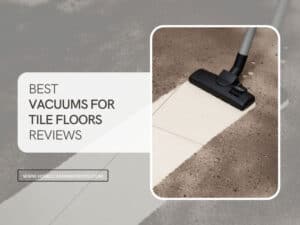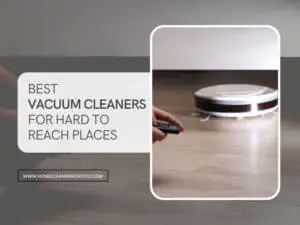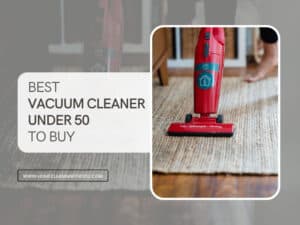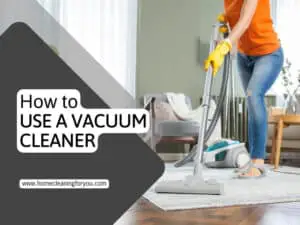Ways to Clean Your Dyson Vacuum Effortlessly
So, how to clean a Dyson vacuum without breaking it down? Most people claim that it’s best to seek help from a professional. Nonetheless, this post will prove that you can do it on your own, and it’s pretty straightforward.
Therefore, if your vacuum is not working as it should or making weird sounds, it’s about time you cleaned it. Read on, and I’ll show you how to do it with minimal effort. Rest assured that your Dyson vacuum will be good as new so long as you follow my guide!

How Often Should A Dyson Vacuum Be Cleaned?
Undoubtedly, Dyson is one of the leading names in the household appliance industry. It was founded in 1991 and remains popular with a wide range of products. From air purifiers, hair dryers to vacuum cleaners, they are beloved for their reasonable cost and efficiency. (1)
Below is the list of some of the best-selling vacuums from Dyson:
- Dyson V15 Detect: Best Overall
- Dyson V8: Best Budget
- Dyson Ball Animal 2: Best For Pet Owners
- Dyson Ball Multi Floor Vacuum: Best For Confined Space
If you have a Dyson vacuum, you know how effortless it is to use. All you need to do is plug it in the power outlet and run it over the floor. It can suck in dirt, debris, and other minuscule particles within just a round or two.
However, the device’s performance will decline over time. Don’t blame it, though, because it has given its all for keeping your house clean and shiny. Now, it’s your turn to do something to return the favor.
According to most experts, you should clean your vacuum every 12-18 months. Meanwhile, other components like the filter will require more thorough attention since it can be clogged up with dirt and debris.
The filter should be cleaned once per week if you vacuum daily. If you only use the vacuum on some occasions, you can clean the filter once or twice monthly. That way, you can keep your vacuum running strong and efficient for a long time.
A Detailed Guide On Cleaning A Dyson Vacuum
Before starting the work, take out the manual’s guide. Not all Dyson vacuums have the same design and function, so this section will only provide you with a general description. For more details, you will need to go over the manual.
The instructions below apply to most Dyson models.
Note: Should you lose the manual, type out the vacuum’s serial number on Dyson’s website. All information about your device will pop up.
What You Need
- Microfiber cloth
- Scissors or seam ripper
- Compressed air device
- Flat-head screwdriver or coin (optional)
- Vinegar or baking soda (optional)
Step 1: Disconnect The Power
Check to see whether your vacuum hose is still attached to the outlet. If it is, unplug it. This will not only help you keep you safe from electrical shock but also prevent damage to your device. If you have a cordless model, move on to step 2.
Step 2: Dispose Of The Canister’s Content

All Dyson vacuums are bagless, so you get to save a small fortune on buying replacement bags. However, they also come with a flaw. Without regular cleaning and maintenance, the canister will lose its efficiency or eventually break down.
To clean the canister, you will need to locate it first. Typically, it’s underneath the cyclone and can be opened by pressing a red button. The button’s position will also vary according to your model, but it should not be too difficult to spot it.
To begin with, empty the canister’s content. Then, clean the interior thoroughly with a damp washcloth. A microfiber cloth is your best bet for this job since it can suck up loose particles easily. Allow your canister to dry before closing the vault.
Note: Chemical products, such as dish soap or bleach, are not recommended by Dyson. If you want to clear out the gunk at the bottom, a compressed air device can be just the thing you need.
Step 3: Wash The Filter

Moving on, you will clean the vacuum’s filter, which is perhaps the dirtiest part of the device. Its job is to trap dirt, pet hair, and other loose particles invisible to the naked eye.
Therefore, it’s utterly essential to clean the filter regularly. Some new models will even notify you that it needs cleaning!
Again, to find out where the filter is, you can read over the manual book. You will mostly find it near the cyclone. Some models will have a spare filter located at the back of the device as well. Pull them out.
Wash the filter under the tap to eliminate the properties. For stuck-in dust or debris, you can use an old toothbrush to scrub it out. Let it air dry for about 24 hours once done. To cut back on waiting time, you can squeeze the part slightly to extract the remaining moisture.
Note: Do not dry the filters in a tumble dryer.
Wash the filters to ensure your device’s power and efficiency. Watch this video to know:
Step 4: Clean The Brush Bar

Like the filter, the brush bar collects embedded dirt, hair, and other particles. It is also called a beater or bristle bar in some user guides. Over time, with build-up accumulated along the ruts, the brush bar can become tangled and unable to do its job well.
The brush bar is visible upon removing the soleplate. You can pull this part out by hand, but some models will require you to unscrew with a flat-head screwdriver. Alternatively, you can use a small coin to turn the dial and extract the brush bar.
Next, remove the large chunks of dirt and hair from the bar. You can do this by hand (gloves on if needed) or with scissors to trim off the stuck hair. Finally, wipe the brush bar with a rag and set them aside to dry.
Note: A seam ripper can be substituted for scissors.
Clean a Dyson vacuum’s brush bar like a pro with this no-fail guide. Watch this video:
Step 5: Inspect The Hose

A deep-cleaning treatment is essential to prevent the hose from blockage. Should you hear strange noises coming from the hose or the hose has no suction, you will want to check its inside. Remove the hose from the unit as instructed in the manual.
Then, peek inside to see if any obstructions are blocking the hose. If there are, pull them out gently with a wire hanger. Another trick is to shove a broomstick down the hole. Be cautious, or you will cause the hose to puncture.
If the hose has holes or cracks on it, you should have it fixed or replaced.
Once the hose is clear of dirt and other debris, submerge it with warm water. If it gives off a musty odor, add an extra cup of vinegar or baking soda and stir well. Dry the hose properly before reassembling it.
Your vacuum cleaner will suck like new once the hose is entirely cleaned. Watch this video:
Step 6: Wipe The Vacuum’s Exterior
As the components dry out, continue cleaning the vacuum’s outer body. You can do it using a damp microfiber cloth and give the entire surface a quick wipe. Replace new cloths when the old one becomes mucky. Don’t forget to check the wheels, too.
Note: Do not proceed to clean the vacuum with a soaking wet cloth.
Step 7: Reassemble The Vacuum
After 24 hours, every individual part should become fully dry. Put them back into the unit as you removed them earlier. If you are unsure where to begin, consult the manual.
Note: Ensure that everything is completely dry before reinstallation. Even a few water drops can cause the vacuum to malfunction or mold to grow.
Assemble a Dyson vacuum is straightforward with this extensive guide. Watch this video to know:
Cleaning A Dyson Vacuum Is Easier With These Tricks
Everyone has their first time, so don’t be shy if you happen to mess something up. The next section will troubleshoot your issues with plenty of valuable tips. Check it out!
- Conduct Your Work Outside: As you take the vacuum apart, a whopping amount of dirt, dust, and other microscopic particles will spew out and float around your house. If you or your family is highly sensitive, this can cause several health problems.(2)
- Wear Protective Gear: This is a good idea if you are allergic to dust. What’s more, you will sometimes find tiny pins or sharp objects lurking inside the machine parts. Therefore, put on an air mask and rubber gloves for safety reasons.
- Always Check The Manual: As mentioned, Dyson vacuums are not cookie cutters. They are different in many aspects, so it’s best to have your manual with you while cleaning.
- Read The Warranty: Don’t skip reading the warranty to find out the dos and don’ts! For instance, you won’t be covered if you rinse the cyclone with warm water. If the warranty is still good, contact Dyson.
- Inspect The Vacuum’s Parts: Cleaning the vacuum is also an opportunity to check its condition. If you notice fractures, openings, or faulty parts, stop the process and purchase new replacements. There’s no need to waste your effort.
- Avoid Soap Or Detergent: As stated by Dyson, cleaning the vacuum using soap or detergent is a big no. Of course, harsh chemicals like bleach must be avoided at all costs since they can eat through the material.
And, here’s a friendly reminder: if problems arise as you are cleaning the device or parts of it, immediately stop what you are doing. Instead, call in an expert (preferably from Dyson if your warranty is still valid) or someone with in-depth knowledge about vacuums.
FAQs
Cleaning a Dyson vacuum is not difficult, but I believe that some questions are still running around your head. If so, the following section is a must-read.
Proper Cleaning Will Prolong Your Dyson’s Vacuum Life
That’s all you need to know about how to clean a Dyson vacuum. From now on, you should clean your device frequently to ensure optimal performance. In addition, remember to dump the bin once it’s halfway full and, indeed, don’t force it to work too much!
Enjoying my post so far? Link it to someone with a Dyson vacuum – they will probably need these instructions. And, provided that you have extra questions about the cleaning process, feel free to comment below. I promise that I’ll get to all of them!

References
- En.wikipedia.org. 2021. Dyson (company) – Wikipedia. [online] Available at: <https://en.wikipedia.org/wiki/Dyson_(company)>.
- ACAAI Public Website. 2021. Dust Allergy | Causes, Symptoms & Treatment | ACAAI Public Website. [online] Available at: <https://acaai.org/allergies/allergic-conditions/dust-allergies/>.







Kevin Jones
Founder & Chief Home Organization Strategist
Expertise
Home Organization & Decluttering, Efficient Cleaning Methods & Stain Removal, Sustainable Cleaning Practices, DIY Home Maintenance & Repairs, Space Optimization & Storage Solutions, Budget-Friendly Home Care Strategies
Education
University of Texas at Austin
Kevin Jones is the Founder and Chief Home Organization Strategist at HomeCleaningForYou.com.
He earned a Bachelor of Science in Interior Design from the University of Texas at Austin, focusing on space planning and sustainable design. Specializing in home organization, decluttering, and budget-friendly home care, he helps homeowners create functional and stylish spaces.
Kevin has been featured in lifestyle publications and has collaborated with eco-friendly brands on home organization solutions. He shares his expertise through DIY guides, workshops, and online tutorials. Passionate about minimalism, he enjoys testing new organization methods and exploring sustainable living ideas.